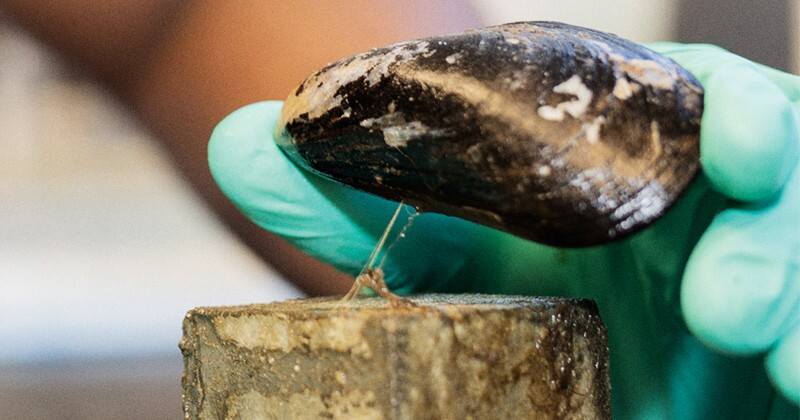A University of Delaware professor is drawing inspiration from shellfish to develop resilient adhesives for affordable housing and next-generation infrastructure.
Jovan Tatar, an assistant professor of civil and environmental engineering and an affiliated faculty in theCenter for Composite Materials, received a prestigious NSF CAREER Award to create new durable adhesive joints for concrete structures by mimicking mussel adhesion — how the shellfish stick to things.
Concrete — a mix of water, gravel or rock, and cement — is a useful building material for many structures, from museums to bridges. To join two hardened concrete surfaces together and glue other structural materials to concrete, engineers must use a special adhesive, a super-strong type of glue.
Existing concrete adhesives are not durable when exposed to moisture, said Tatar, and that’s a problem. Most adhesives do not bond well to damp surfaces, and concrete is, intrinsically, a moist material. In addition, many concrete structures, such as bridges and building exteriors, are often exposed to water.
In fields such as the automotive and aerospace industries, engineers use special adhesives to accelerate production, prolong product life, reduce stress concentrations, and control maintenance costs, said Tatar.
“Similar benefits could be attained in the structural engineering field with adhesives that are specifically designed to withstand the environmental stressors and structural demand in concrete structures,” he said. “This need in the field has inspired me to seek nature-inspired solutions for durable adhesive bonding to concrete.”
Mussels piqued his interest because of their ability to establish and maintain adhesion underwater, on substances made of minerals similar to those found in concrete. Before they end up in your bouillabaisse, mussels live in shallow waters and make special proteins that allow them to plod along and stick to surfaces.
A National Institute of Standards and Technology (NIST) report recently identified externally bonded fiber-reinforced polymer (EBFRP) composite retrofits, which strengthen structures made of reinforced concrete, as critical for making concrete infrastructure more resilient to natural disasters and restoring decaying urban infrastructure. NIST identified the durability of adhesive bonds to concrete in structures where moisture is a significant concern — such as along coastlines — as the highest priority research area.
“By enabling durable adhesive bonding to concrete, this project will improve the durability of EBFRP retrofits, which addresses two important needs: the National Earthquake Hazards Reduction Program’s call to improving retrofit technology; and the National Academy of Engineering’s Grand Challenge to restore and improve urban infrastructure,” said Tatar.
After all, to keep up with rapid urbanization, it is estimated that the construction industry must deliver over 13,000 buildings (excluding single-family homes) per day across the world by 2050, which is 3,600 buildings above the current rate of production, he said.
“The booming urban population will also generate unprecedented demand for affordable housing and next-generation infrastructure to support sustainable growth,” said Tatar. “To meet the needs of modern society, the construction industry must substantially accelerate production which will likely be possible through prefabricated construction and additive manufacturing.”
New, stronger adhesives could join together prefabricated structural components and combine layers of 3D-printed concrete in a way that promotes structural integrity and enables the seamless transfer of loads through a structure.
“I envision fundamental advances in the understanding of bio-inspired adhesion to concrete will enable the development of durable adhesive joining techniques that support innovation and increase productivity in the construction sector,” said Tatar.
Outreach for students with ADHD
Every NSF CAREER Award has an outreach component, an opportunity for scientists to engage with the community and promote STEM.
In this portion of this project, Tatar is focusing on outreach to individuals with ADHD. As he wrote in his proposal: “Increasingly wicked problems require disruptive solutions; most often, these originate in highly creative, interdisciplinary teams. Individuals with ADHD exhibit creativity to a much greater extent than the neurotypical population, along with cognitive disinhibition that allows them to consider ideas outside their field. These qualities do not serve them well as engineering students, however — they are twice as likely to change majors after their first year as their neurotypical peers, largely because engineering curricula rely on teacher-centered modes of instruction which are not sufficiently open to diversity in learning. The overarching goal of my education plan is to nurture a cadre of highly creative engineers capable of creating transformative knowledge.”
Tatar will design accessible outreach activities for students in grades 4 through 12 in collaboration with UD Engineering’s K-12 Outreach group. He will provide summer research internships and personalized mentoring for high school students and first-year undergraduates with ADHD.
This aligns with Tatar’s research, which requires out-of-the-box thinking and is highly interdisciplinary — he’s collaborating with faculty in biology, biomechanics, surface science, quantum chemistry and materials engineering.
Tatar joined UD in 2018 after two years as an assistant professor at the University of Louisiana at Lafayette. He holds a doctoral degree and master’s degree in civil engineering from the University of Florida and a bachelor’s degree in civil engineering from the University of Montenegro.
